Hierarchical silver hybrid particles are cheap to make and have good catalytic activity

The gel-like inner skin of jellyfish can be used as a template for the simple synthesis of dendritic silver nanoparticles. The novel production method takes advantage of the jellyfish’s fibrous microstructure, creating a cheap hybrid nanomaterial that demonstrated good catalytic activity.
With applications in such wide areas as catalysis, electronics, optics and biomedicine, noble metal nanoparticles have made waves in chemistry. Dendritic or branching silver nanoparticles are of particular interest, as they are relatively cheap and their hierarchical structure makes them good catalysts.
While there are many methods of manufacturing silver dendrites, conventional synthesis processes tend to be complicated and expensive. Expanding on their previous work with biological hydrogels, however, Ya-Nan Chen and Huiliang Wang of the Beijing Normal University have demonstrated that the inner skin of jellyfish – the mesoglea – may offer a simpler and novel approach.
Surrounded by two protective layers of skin and making up most of the jellyfish’s umbrella, the mesoglea is a translucent, non-living gel composed of proteins and fatty acids. The proteins and fatty acids form a unique, layered microstructure of nano-sized fibres and membranes, with pores of many different shapes and sizes.
The researchers cut small samples of mesoglea from the edible jellyfish, Rhopilema esculenta, and then soaked them in solutions of silver nitrate – of various concentrations – for three days. The silver nitrate was then reduced by placing the samples into a solution of sodium borohydride – leading to the formation of silver nanoparticles.

The team found that different concentrations of silver nitrate changed the nanoparticles’ morphologies. Simple nanoparticles of varying sizes formed at low concentrations, while fibres and then increasingly-branched dendrites developed at higher concentrations.
The researchers propose that the silver fibres form along the paths of the mesoglea’s original nanofibres to create the hybrid biogel–nanoparticle. The uneven formation of these fibres, which ultimately become the trunks of the dendrites, results in bumps that develop into branches.
‘In comparison to the alternatives, our method of dendrite synthesis is very low cost, extremely simple and time-saving,’ says Wang. He adds that the process needs no expensive equipment and that – at around £4/kg – the jellyfish can be obtained extremely cheaply and readily.
To demonstrate the effectiveness of the resulting hybrid gel, the researchers conducted tests using the dendrites to reduce 4-nitrophenol to 4-aminophenol, reporting both good catalytic activity as well as an excellent level of recyclability.
The work is a very creative approach to nanomaterial synthesis, comments Terry Bigioni, a nanoparticle chemist at the University of Toledo, US, who was not involved in this study. He adds: ‘It’s amazing that nature has provided a structure so well suited for growing these structures.’
The researchers are now exploring the use of jellyfish mesoglea in the synthesis of other metal nanoparticles – such as gold and copper – along with investigating other possible applications for these hybrid materials.












No comments yet